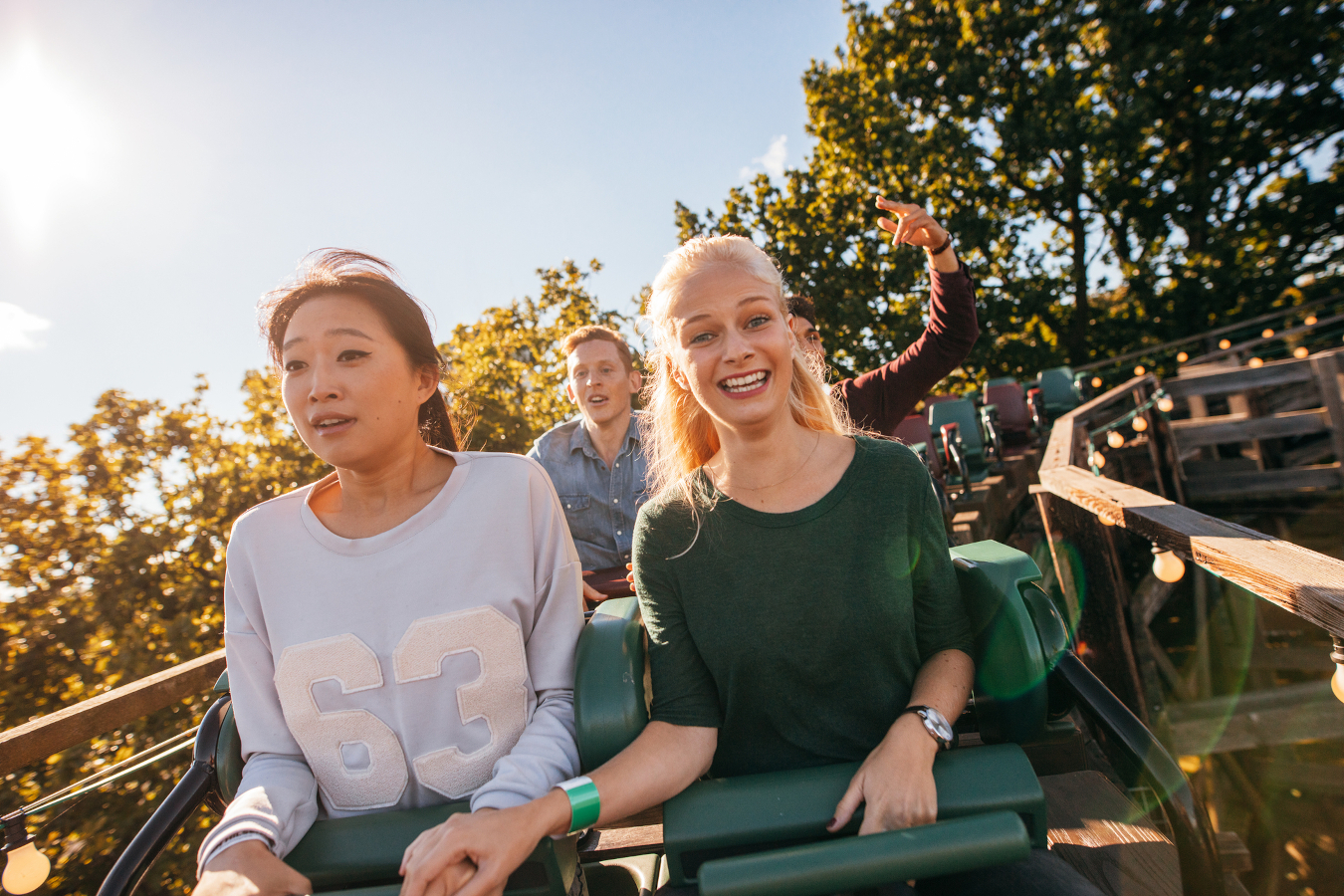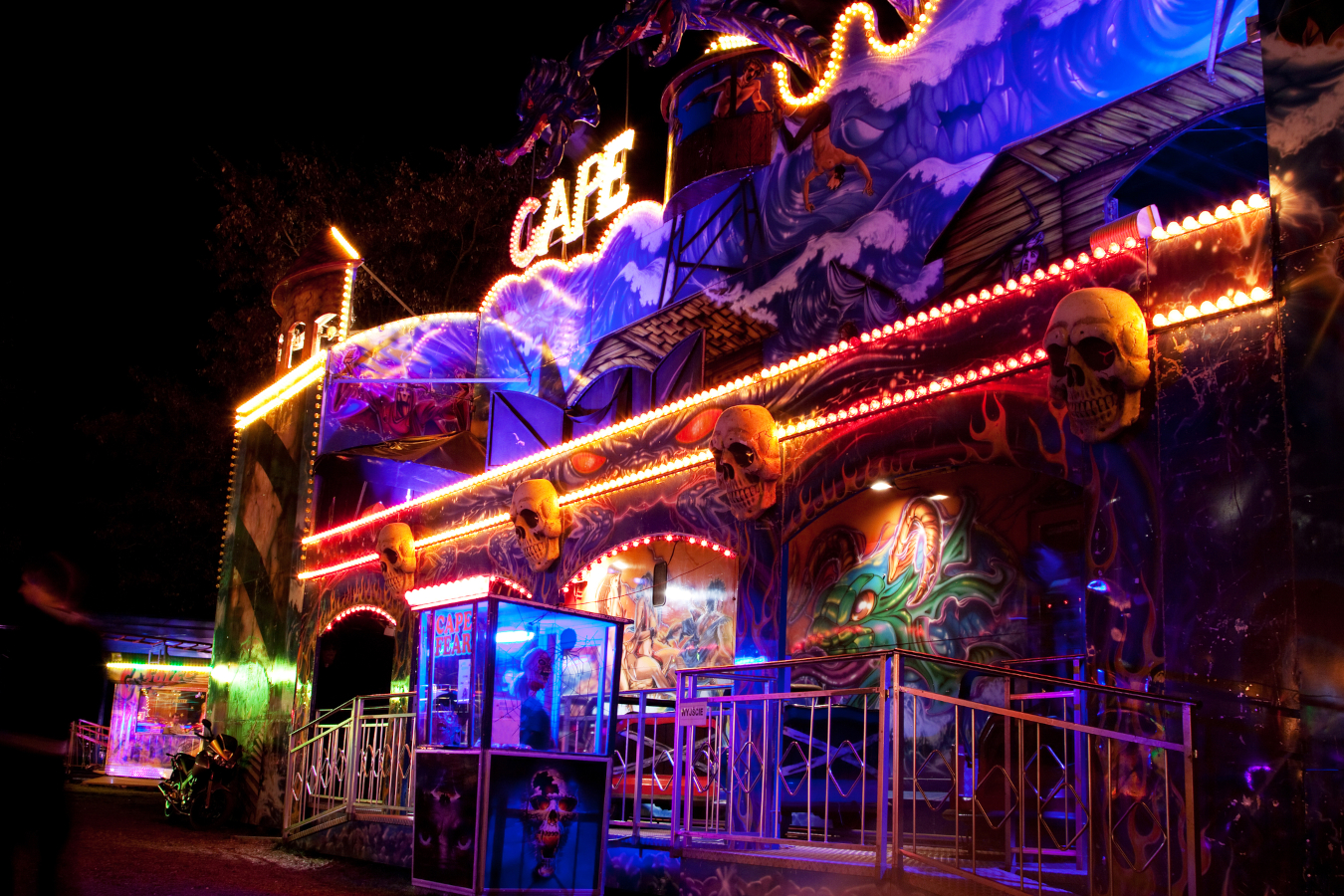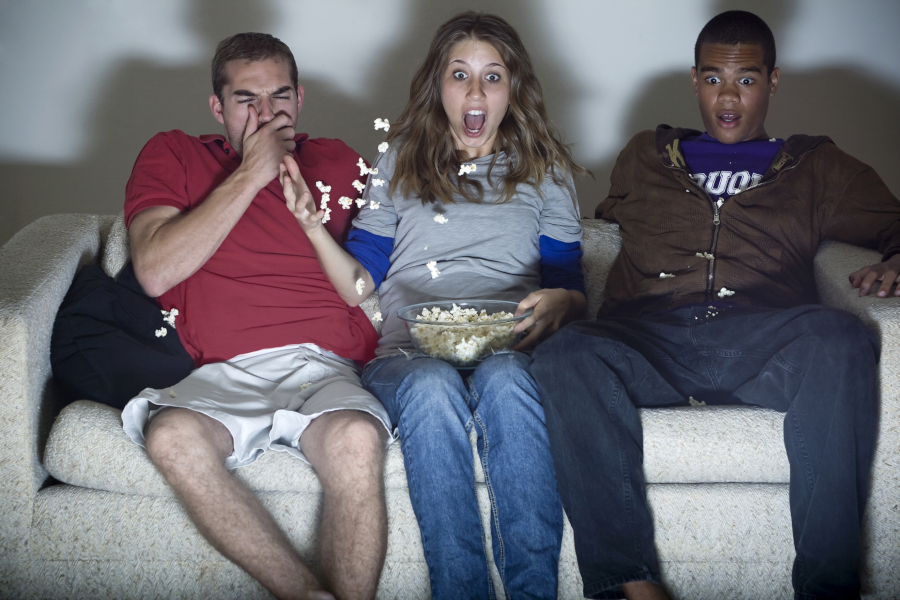We do a funny thing: we pay money to get chased by zombies, queue for roller coasters that make our knees wobble, and stream horror movies that have us peeking through our fingers. So why do people enjoy being scared? Isn’t fear supposed to be something we avoid?
Scientists call this phenomenon recreational fear, and understanding why fear can actually feel good reveals fascinating things about our brains, psychology, and even social behavior.
ID 88706794 ©Ammentorp | Dreamstime.com
I first went on a roller coaster 19 years ago with my husband, at Prater Park in Vienna. It was terrifying! I remember gripping the safety bar and thinking, never again – especially since I’ve always had a bit of a fear of heights.
Fast forward to last year, at LEGOLAND® Deutschland Resort, where my son convinced me to join him on the Jungle X-pedition water coaster. Let’s just say it confirmed my earlier conclusion: I’m not a roller coaster person. But I did it anyway – because I wanted to share that special, laughter-filled moment with him.
That said, I can handle a good scare from the comfort of my couch. I enjoy classic Hitchcock thrillers and select newer horror movies (though not all of them!). There’s something fascinating about controlled fear – when you know you can stop the movie or look away if it’s too much.
As a funny side note, I recently shared an article called Don’t Go In There! 15 Hilariously Dumb Things Horror Movie Characters Always Do (That We Secretly Love) – because let’s be honest, we all roll our eyes at those moments while secretly loving every second of them. If you haven’t read it yet, you’ll probably get a good laugh (and a few knowing nods) out of it.
My mixed relationship with fear made me curious about the science behind it – why some people crave horror movies or thrill rides while others (like me) can barely handle them. So I decided to dig into what psychologists and neuroscientists have discovered about the psychology of fear and enjoyment.
Over the past decade, psychologists and neuroscientists have started to answer this paradox. Their verdict: when fear is voluntary, time-limited, and safe – think horror films, haunted houses, escape rooms, roller coasters, or spooky games – it can feel not just tolerable, but deeply enjoyable and even useful. The emerging field studying this is often called recreational fear.
Below you’ll find 12 evidence-based reasons we love being scared, each grounded in peer-reviewed studies or guidance from relevant institutions. I’ve also included cautions and disclaimers so you can enjoy the thrills wisely.
These findings reveal why fear can be fun, what happens in your brain when you get scared on purpose, and how controlled fear can even help you build emotional resilience.
Why We Love Being Scared: 12 Science-Backed Reasons (and How to Stay Safe)
1) The “Goldilocks” or “Sweet-Spot” Principle: fear is most fun at a moderate level
ID 14020190 ©BrunoWeltmann | Dreamstime.com
A landmark field experiment wired up visitors in a professional haunted house with heart-rate sensors and measured their moment-to-moment feelings.
The team found an inverted-U pattern: enjoyment was highest at moderate fear, and dropped when fear was too little (boring) or too much (overwhelming). In other words, there’s a personal “just right” level of fear.
This helps explain why some people love slow-burn dread while others prefer jump scares – your sweet spot may differ. The same research program (Aarhus University’s Recreational Fear Lab) has replicated and expanded these findings in multiple haunted-house and media studies.
2) Fear can piggyback pleasure: dopamine, endorphins, and arousal
Scary entertainment kicks the fight-or-flight system into gear. In safe contexts, the sympathetic surge (adrenaline, elevated heart rate) is often accompanied by dopamine and endorphins, which can feel energizing and euphoric – especially when the “threat” ends and your body returns to baseline.
Reviews and explainers from health and psychology sources describe this cascade; it mirrors what many experience as a “runner’s high.”
A 2018 field study at an “extreme” haunted house found that participants reported better mood and reduced anxiety after the experience, and some showed decreased neural reactivity consistent with a post-challenge “calm.”
3) Excitation transfer: the relief after fear feels extra good
One classic theory – excitation transfer – says the physiological arousal triggered by fear can intensify subsequent positive emotions (like relief or triumph) when the scare resolves.
Horror’s roller-coaster pacing leverages this: tension goes up, then releases – ahhh. Contemporary overviews and reviews on why people enjoy horror point to excitation transfer as a key mechanism.
I already mentioned: my sweet spot is waaay lower than a roller-coaster!
4) Misattribution of arousal: fear can make things (and people) seem more exciting
As a note, this was surprising for me when I learned about this. So I am sharing this – I am curious what you think.
The famous suspension-bridge experiment showed that people who met an attractive interviewer on a high, shaky bridge (vs. a safe, low bridge) were more likely to interpret their heightened arousal as attraction. This “misattribution of arousal” helps explain why scary dates can feel electric.
5) Sensation seeking: some of us are wired for stronger thrills
Individual differences matter. People high in sensation seeking – a personality trait studied for decades – tend to prefer intense, novel experiences and are more likely to enjoy horror.
Recent research continues to find positive links between fearfulness of scenes and enjoyment/excitement ratings, especially among those who watch horror and score higher in morbid curiosity.
6) Morbid curiosity: we’re drawn to learn about threats – safely
ID 10979721 ©Ariel Dunn | Dreamstime.com
Morbid curiosity is not a flaw; it’s a measurable, normally occurring trait (if you did not read the article with funny things people do in horror movies, linked at the beginning of this article, now is really the best and most relevant time!).
People high in morbid curiosity are more interested in information about danger, disease, and death – the stuff we evolved to monitor – when it’s safe to do so. The Morbid Curiosity Scale formalizes this tendency, and related work during COVID-19 showed morbid curiosity predicted interest in pandemic news and outbreak fiction. How fascinating is this?
7) Practice runs for the real world: fear as emotional training wheels
A popular hypothesis is that recreational fear acts as a simulation engine: we practice detecting, regulating, and recovering from threat – skills that generalize to real life.
In haunted-house and media studies, researchers observe people self-regulating (down-regulating when fear spikes; up-regulating when bored) to stay near their personal sweet spot, which likely builds emotion-regulation skills over time.
There’s also suggestive evidence that horror fans showed greater psychological resilience during the early pandemic, consistent with the idea that repeated “safe scares” can help people cope with uncertainty.
8) Social bonding: sharing scares brings us closer
Fear is contagious – and social. Screaming together in a theater or clutching a friend in a haunted maze can strengthen bonds. The arousal from fear can also spill over into social warmth or attraction (see #4).
Popular summaries and psychology explainers note that couples and friend groups often use scary entertainment as a way to connect and feel “in it together.”
9) The post-scare calm: a surprising “zen” effect
That haunted-house study mentioned earlier reported reductions in overall brain activity right after the experience, which the authors likened to a temporary “zen” state.
Many participants felt happier and less anxious after the controlled scare. This “calm after the storm” is one reason people describe scary play as stress-relieving – provided they want to be there. (see the article cited at #2)
10) It’s educational: we learn what scares us and how to steer it
Field studies in horror attractions show participants monitor and manage their own arousal, experimenting with attention (looking away vs. leaning in), humor, or breathing to dial fear up or down.
Over time, this can teach better self-awareness and emotion regulation – skills that are useful far beyond Halloween. (see the study quoted at #7)
11) Overlap with evidence-based therapies (with big caveats)
In clinical psychology, exposure therapy – gradually and safely confronting feared stimuli – has strong evidence for treating phobias and PTSD. Recreational fear is not therapy, but it resembles exposure principles (safe, voluntary, repeatable contact with fears), which may explain some mood benefits. I cannot say anything about whether this is efficient or not – I know that there are official resources for specialists, from reputable sources. I am presenting this here because it was related to the topic of this article.
12) New fronts: from lab to inflammation and beyond
Science is still young and expanding. Recent work continues to analyze how fear, enjoyment, and curiosity interact in horror scenes, and even explores physiological ripple effects of recreational fear (e.g., inflammatory responses) in field contexts like haunted houses. Expect more nuance on who benefits, when, and why.
FAQ: Why We Love Being Scared – Science-Based Answers
Is it actually healthy – or even good – for you to get scared on purpose?
For many healthy adults who enjoy it, short, controlled scares can boost mood and feel invigorating. According to health explainers, the reaction is a bit like brief aerobic exertion – a quick adrenaline kick followed by a calm, relaxed state. You get a sympathetic kick and a post-scare calm. But enjoyment is individual, and benefits rely on voluntary participation.
Does everyone enjoy horror?
No. Personality traits (e.g., sensation seeking, morbid curiosity), past experiences, and context all matter. Many people enjoy scary media only with trusted friends – or not at all – and that’s normal.
Can scary play build resilience?
Preliminary evidence and theory suggest it can, by offering low-stakes practice with fear and uncertainty. But that’s not a substitute for therapy if fear is impairing your life.
Important cautions & disclaimers (please read)
Children and teens: The American Academy of Pediatrics recommends co-viewing and discussing scary content with kids, tailoring choices to age and temperament. Media violence exposure can contribute to nightmares and anxiety; use parental guides and a family media plan. When in doubt, scale back intensity.
Trauma and anxiety disorders: If you have PTSD, severe anxiety, or phobias, don’t self-expose to triggers hoping to “fix it.” Exposure therapy is effective when guided by a trained clinician who can keep it gradual and safe. Talk to a licensed therapist; the APA and VA offer helpful overviews of evidence-based care.
Heart and cardiovascular concerns: Most healthy adults tolerate scary entertainment well, but sudden scares temporarily raise heart rate and blood pressure. If you have heart disease or significant risk factors, choose gentler options and consult your clinician. The American Heart Association notes that while extreme adverse events are rare, caution is warranted if you experience chest pain, shortness of breath, or palpitations – seek medical attention.
Consent and context matter: The benefits described here apply to voluntary, time-limited, safe scares. If you feel distressed, pressured, or emotionally flooded, step away. There is no virtue in forcing yourself.
How to find your sweet spot (science-informed tips)
Photo source: Pixabay
Start low and go slow. Choose milder thrills (spooky mystery, suspenseful TV) and ratchet up only if you’re comfortable. This aligns with exposure principles: gradual increases beat flooding.
Co-pilot your fear. Borrow a page from haunted-house visitors who self-regulate: adjust attention (peek vs. full stare), add humor, or practice slow breathing during tense scenes.
Make it social. Watching with friends can buffer fear and amplify fun through social bonding.
Debrief the ending. Part of the pleasure is the relief – talk through favorite scenes and what you learned about your reactions. (That reflection helps move “practice” into everyday resilience.)
My Conclusion (of sorts)
We love being scared when it’s safe, short, and self-chosen because it hits a biopsychological sweet spot: enough arousal to feel alive, enough control to feel safe, and enough narrative closure to convert tension into triumph. That recipe taps dopamine and endorphins, strengthens social bonds, and offers low-stakes rehearsal for real-world stress. Not everyone enjoys it – and that’s okay. But if you do, science says you’re not strange; you’re skill-building.
I wanted to discover why we sometimes love fear and what sets us apart. Yes, I do NOT like to be scared (the movies I watched are not extremely violent or hard-horror – if I can say so. They are mild). But I know people who are thrill seekers – I am the opposite.
I believe we should always prioritize our safety – and fear can help us do that. But, in right amounts and controlled environments, fear seems to have some benefits. I hope this article was as eye-opening for you as it was for me to discover all of these prior to putting it all together in this material.
Whether it’s watching a scary movie, exploring a haunted house, or taking on a thrilling roller coaster, the science of fear reminds us that being scared isn’t always bad – it can actually be good for your brain, body, and emotional health.
So the next time you wonder why we love being scared, you’ll know it’s more than adrenaline – it’s how we learn, connect, and grow stronger through the psychology of safe fear.
Speaking of interesting articles, I recently presented you on this site some studies with different recommendations of EASY things to do to live happily and long:
- Scientists Reveal the Unexpected Longevity Habit That Costs Nothing
- Scientists Say This Overlooked Habit Could Add Years to Your Life
- Scientists Say People With This Mindset Are Far More Likely to Reach Age 90+
- Add Decades, Not Just Years: 8 Habits That Could Add 20–25 Years to Your Life (Backed by a Massive Study)
- Build a Night Routine That Boosts Longevity – What Studies Show
- Want a Longer, Happier Life? Scientists Say This 1-Hour Habit Could Be the Key
- Want to Live Longer? Studies Say These Mental Habits May Help (No Sweat Required)
- Eat Earlier, Live Longer? What a New Study Says About Breakfast Timing, Aging, and Longevity
- Simple daily habits for a healthier mind
- How to De-Clutter Your Mind, Backed by Science
- The Personality Traits That Can Help You Live Longer (and Be Happier)
- How to Build Real Self-Esteem That Lasts (Backed by Science, Not Buzzwords)







